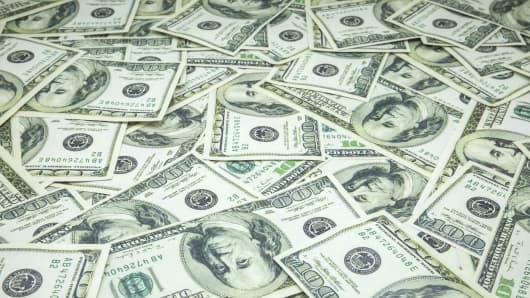Just how high can the dollar rise?
 The U.S. dollar index,
which tracks the dollar's strength against a basket of six currencies
but is primarily weighted toward the euro touched a 12-year high on
Friday. Even more impressive than the level has been the pace—according
to Steven Englander of CitiFX, the dollar's rally over the past eight
months has been its fastest in at least 40 years.
The U.S. dollar index,
which tracks the dollar's strength against a basket of six currencies
but is primarily weighted toward the euro touched a 12-year high on
Friday. Even more impressive than the level has been the pace—according
to Steven Englander of CitiFX, the dollar's rally over the past eight
months has been its fastest in at least 40 years.
But far from being ready to take profits, many dollar bulls continue to say that it's still full-steam ahead for the greenback.
With little resistance in sight on the chart, "we have another 10 percent to go," according to Todd Gordon of TradingAnalysis.com.
In the options market, traders certainly appear to be betting on further dollar gains—and euro losses. In one particularly big trade in the prior week, someone bought a huge number of bearish put spreads on the ETF tracking the euro, the FXE.
"The price they traded suggests at least a 25 percent probability that
we're at parity by year end here," said Stacey Gilbert, head of derivatives strategy with Susquehanna, referring to the state in which each euro costs $1. Currently near $1.05, the euro neared $1.40 in April.
The catalyst for the huge move is clear. The Federal Reserve is preparing to raise short-term rates, which will make it more attractive to hold dollars. Meanwhile, the European Central Bank has just commenced a currency-weakening quantitative easing program. And all this as the U.S. economy far outperforms Europe.
 The U.S. dollar index,
which tracks the dollar's strength against a basket of six currencies
but is primarily weighted toward the euro touched a 12-year high on
Friday. Even more impressive than the level has been the pace—according
to Steven Englander of CitiFX, the dollar's rally over the past eight
months has been its fastest in at least 40 years.
The U.S. dollar index,
which tracks the dollar's strength against a basket of six currencies
but is primarily weighted toward the euro touched a 12-year high on
Friday. Even more impressive than the level has been the pace—according
to Steven Englander of CitiFX, the dollar's rally over the past eight
months has been its fastest in at least 40 years.But far from being ready to take profits, many dollar bulls continue to say that it's still full-steam ahead for the greenback.
With little resistance in sight on the chart, "we have another 10 percent to go," according to Todd Gordon of TradingAnalysis.com.
In the options market, traders certainly appear to be betting on further dollar gains—and euro losses. In one particularly big trade in the prior week, someone bought a huge number of bearish put spreads on the ETF tracking the euro, the FXE.
"The price they traded suggests at least a 25 percent probability that
we're at parity by year end here," said Stacey Gilbert, head of derivatives strategy with Susquehanna, referring to the state in which each euro costs $1. Currently near $1.05, the euro neared $1.40 in April.
The catalyst for the huge move is clear. The Federal Reserve is preparing to raise short-term rates, which will make it more attractive to hold dollars. Meanwhile, the European Central Bank has just commenced a currency-weakening quantitative easing program. And all this as the U.S. economy far outperforms Europe.
This week, the key event for currency traders is Wednesday's
Federal Reserve announcement, where the Fed will either include or
strike the word "patient" in its guidance. If it does the latter, the
central bank would technically be open to raising rates as soon as June.
Still, not everyone suggests being long dollars in the event.
"I am long-term bullish dollars, but I think the Fed is going to put the brakes on the dollar next week," said Kathy Lien, managing director of FX Strategy with BK Asset Management. "The speed and velocity of the recent moves brings back the risk of disinflation."
Still, not everyone suggests being long dollars in the event.
"I am long-term bullish dollars, but I think the Fed is going to put the brakes on the dollar next week," said Kathy Lien, managing director of FX Strategy with BK Asset Management. "The speed and velocity of the recent moves brings back the risk of disinflation."
That is, if the dollar keeps rising, inflation in the U.S.
could slow. This would be a thorn Fed's side, given that inflation is
already running below the central bank's stated goal of 2 percent per
year.
"While I expect the Fed to drop the word 'patient' from the FOMC statement, [Fed Chair Janet] Yellen's top priority will be to downplay the rush to raise rates—and if she does, it could lead to a 2 to 4 percent correction in the greenback," Lien said. "I would view that as a great buying opportunity."
"While I expect the Fed to drop the word 'patient' from the FOMC statement, [Fed Chair Janet] Yellen's top priority will be to downplay the rush to raise rates—and if she does, it could lead to a 2 to 4 percent correction in the greenback," Lien said. "I would view that as a great buying opportunity."

No comments:
Post a Comment